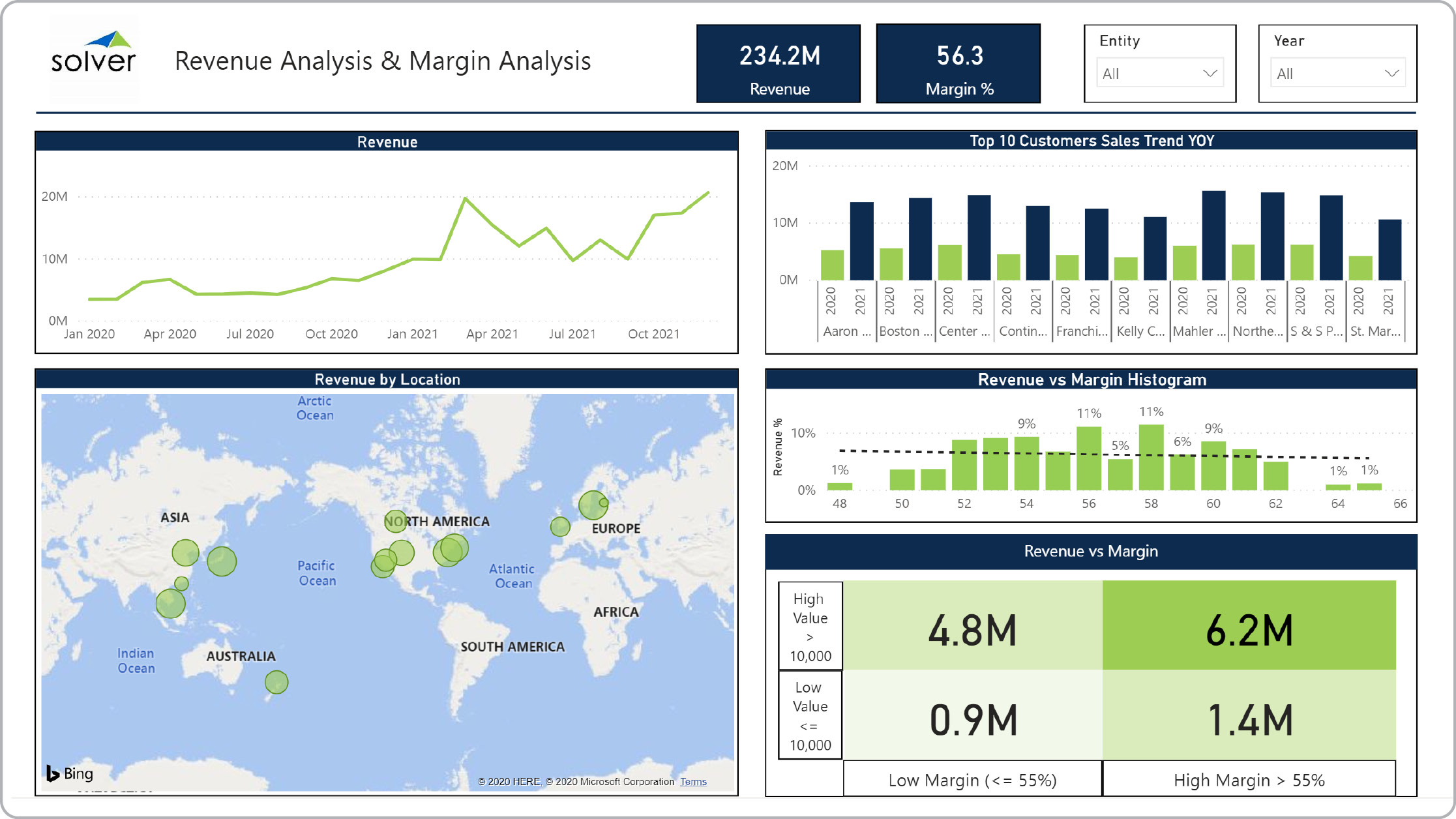Revenue Dashboard for Distributors
What is a
Revenue Dashboard for Distributors
? Revenue and Margin Dashboards are considered analysis tools and are used by executives and sales managers analyze revenue-related metrics. Some of the main functionality in this type of dashboard is that it provides six different views of sales and margin KPIs, including: 1) Revenue and gross Margin %, 2) Multiyear revenue trend, 3) Revenue by location, 4) Top 10 customers by sales for current versus prior year, 5) Revenue and margin histogram, and 6) Revenue and gross margin analysis by deal size. The filters in the top right corner enables drill-down into specific business units and periods. You find an example of this type of dashboard below.
Purpose of
Revenue and Margin Dashboards Distributors use Revenue and Margin Dashboards to give managers an easy, single screen interface to monitor key sales-related metrics. When used as part of good business practices in a Financial Planning & Analysis (FP&A) and Sales department, an organization can improve and speed up its revenue tactics and increase profitability, and it can reduce the chances that users miss the most important data that should drive their decisions.
Revenue and Margin Dashboards for Distributor
s - Example Here is an example of a Revenue Dashboard for distributors that displays margins and trends from different viewpoints. [caption id="" align="alignnone" width="2233"]
 Revenue Dashboard Example for Distributors[/caption] You can find hundreds of additional examples
here
Who Uses This Type of
Dashboard
? The typical users of this type of dashboard are: Executives, finance officers, sales managers.
Other Reports Often Used in Conjunction with
Revenue and Margin Dashboards Progressive Financial Planning & Analysis (FP&A) and Sales departments sometimes use several different Revenue and Margin Dashboards, along with detailed sales reports, financial dashboards, sales forecasts, financial statements and other management and control tools.
Where Does the Data for Analysis Originate From? The Actual (historical transactions) data typically comes from enterprise resource planning (ERP) systems like: Microsoft Dynamics 365 (D365) Finance, Microsoft Dynamics 365 Business Central (D365 BC), Microsoft Dynamics AX, Microsoft Dynamics NAV, Microsoft Dynamics GP, Microsoft Dynamics SL, Sage Intacct, Sage 100, Sage 300, Sage 500, Sage X3, SAP Business One, SAP ByDesign, Acumatica, Netsuite and others. In analyses where budgets or forecasts are used, the planning data most often originates from in-house Excel spreadsheet models or from professional corporate performance management (CPM/EPM) solutions.
What Tools are Typically used for Reporting, Planning and Dashboards? Examples of business software used with the data and ERPs mentioned above are:
Revenue Dashboard Example for Distributors[/caption] You can find hundreds of additional examples
here
Who Uses This Type of
Dashboard
? The typical users of this type of dashboard are: Executives, finance officers, sales managers.
Other Reports Often Used in Conjunction with
Revenue and Margin Dashboards Progressive Financial Planning & Analysis (FP&A) and Sales departments sometimes use several different Revenue and Margin Dashboards, along with detailed sales reports, financial dashboards, sales forecasts, financial statements and other management and control tools.
Where Does the Data for Analysis Originate From? The Actual (historical transactions) data typically comes from enterprise resource planning (ERP) systems like: Microsoft Dynamics 365 (D365) Finance, Microsoft Dynamics 365 Business Central (D365 BC), Microsoft Dynamics AX, Microsoft Dynamics NAV, Microsoft Dynamics GP, Microsoft Dynamics SL, Sage Intacct, Sage 100, Sage 300, Sage 500, Sage X3, SAP Business One, SAP ByDesign, Acumatica, Netsuite and others. In analyses where budgets or forecasts are used, the planning data most often originates from in-house Excel spreadsheet models or from professional corporate performance management (CPM/EPM) solutions.
What Tools are Typically used for Reporting, Planning and Dashboards? Examples of business software used with the data and ERPs mentioned above are:
- Native ERP report writers and query tools
- Spreadsheets (for example Microsoft Excel)
- Corporate Performance Management (CPM) tools (for example Solver)
- Dashboards (for example Microsoft Power BI and Tableau)
Corporate Performance Management (CPM) Cloud Solutions and More Examples
February 28, 2021
TAGS:
Reporting,
Solver,
report writer,
Microsoft,
template,
practice,
Acumatica,
visualization,
Netsuite,
Finance,
planning,
GP,
dashboard,
Business Central,
margin,
excel,
ax,
forecast,
Budget,
Dynamics 365,
analysis,
budgeting,
distributor,
revenue,
Cloud,
distribution,
Software,
distribution dashboard,
Tableau,
SAP,
example,
best,
Sage,
BC,
D365,
NAV,
Intacct,
revenue dashboard,
CPM,
report,
SL,
Management,
dynamics,
Power BI

